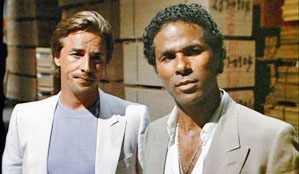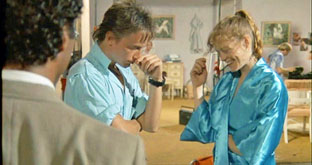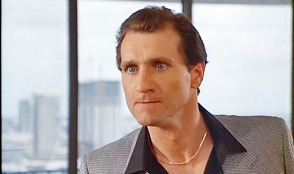Fri 6 May 2016
A TV Episode Review by Jonathan Lewis: MIAMI VICE “Heart of Darkness” (1984).
Posted by Steve under Reviews , TV mysteries[6] Comments

MIAMI VICE. “Heart of Darkness.” NBC, 28 September 1984. (Season 1, Episode 2.) Don Johnson, Philip Michael Thomas, Saundra Santiago, Michael Talbott, John Diehl, Olivia Brown, Gregory Sierra. Guest Cast: Ed O’Neill, Paul Hecht. Created by Andres Carranza & Anthony Yerkovich. Executive producer: Michael Mann. Directed by John Llewellyn Moxey.
Before he portrayed the crudely affable father on Married with Children, Ed O’Neill guest-starred on this rather neo-noir Miami Vice episode. Entitled “Heart of Darkness,†this first season episode is, unlike many extremely dated 1980s cop shows, still eminently watchable today. Stylishly photographed, the episode feels less like a television show and more like a gritty crime film.

O’Neill portrays Arthur Lawson, an undercover FBI agent tasked with investigating an illicit pornography ring and its concurrent corruption. Problem is: under the alias Artie Rollins, Lawson may be having too much fun with his assignment. So much so that the feds believe that Lawson may have changed sides.
“Heart of Darkness,†the second regular Miami Vice episode to be aired on NBC, served to demonstrate to audiences that the series was not going to be just another police procedural. Undercover work wasn’t all fun and games and sometimes the dividing line between cop and criminal would become blurred. The episode was an opportunity to draw out the personalities of the two main lead characters: Detective James Crockett (Don Johnson) and Detective Ricardo Tubbs (Philip Michael Thomas). While Tubbs is quick to assume that Lawson has gone over to the proverbial dark side, Crockett isn’t so sure. A veteran of numerous undercover operations, Crockett sees himself in Rollins and wants to give the G-Man the benefit of the doubt.

Much as in some neo-noir films, the city itself is a character in the unfolding drama. Nightclubs, restaurants, warehouses, boulevards, and luxury condos are the settings that Miami Vice would turn to time and again.
The final shootout, which takes place at the port, reminded me of a similarly filmed scene in Richard Donner’s Lethal Weapon 2 (1989). There’s little romanticism on display here. The world in which Crockett and Tubbs operate is very much a kill-or-be-killed one. The same goes for Arthur Lawson who comes across less as a villain and more as a tragic figure caught between the normal world of middle class domesticity and the seedy underbelly of 1980s urban life.
May 6th, 2016 at 12:27 pm
Thanks for a good review.
I liked this episode very much, when seen in the 1980’s.
The lavish use of locations, design and costumes helped make Miami Vice visually special.
May 6th, 2016 at 5:52 pm
I never watched this show when it was on back in the 80s, but they’re showing it now on the COZI channel, and I like what I’ve seen so far. I don’t know how long they’ve had it on, but this week the shows have all been from the early end of the first season.
May 6th, 2016 at 7:25 pm
I think the scene from MIAMI VICE that stuck with me the longest involved Don Johnson reading the opening description of the house in Cuba from Hemingway’s ISLANDS IN THE STREAM. You didn’t get much of that on other cop shows in the 80’s.
May 7th, 2016 at 1:40 am
Great memory re: the Hemingway quote, David! That was an unusual little moment, but it was a line from a supporting character, a guy in the Bahamas who helps Crockett and Tubbs with their investigation. His character was a bartender/fix it guy who was also an aspiring writer who said he had a 2,000 word novel in the works and that it was a cross between THE CAINE MUTINY and THE ROAD WARRIOR or something like that.
May 7th, 2016 at 1:52 am
“Calderone’s Return: Part 2 – Calderone’s Demise.” The fifth episode of season one.
What was strikingly different about Part 1 was that Gregory Sierra, who played Crockett & Tubb’s superior, Lt. Lou Rodriguez, was killed by an assassin’s bullet meant for Crockett. This I assume was deliberate, to show the audience that all bets were off, and this was a new type of crime drama.
October 16th, 2020 at 4:29 am
I revisited this episode tonight. Still very powerful. Moxey is a TV director whose work I continue to admire.